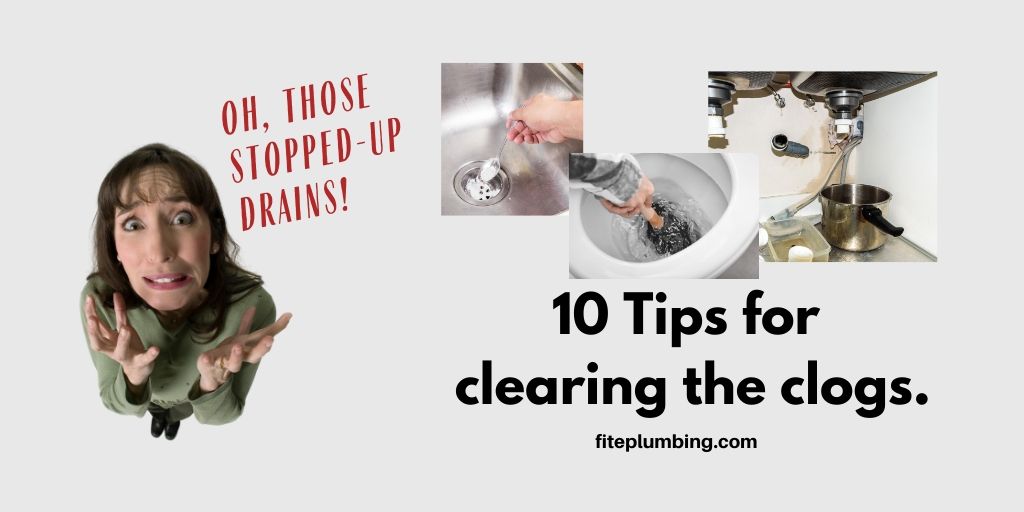Do you find common household clogs annoying? If your bathroom or kitchen sink, or toilet isn’t draining, fixing that clog can be frustrating. There are some simple ways to unclog your drain and get your water moving again. Here are some helpful steps to get your clog unclogged:
Start with a Plunger
The typical “unglamorous” plunger is an effective clog-busting tool, but to ensure that its plunging power is delivered directly to the clog, it’s important to cover any exposed air holes in the sink.
When plunging a bathroom sink, use your thumb to cover the overflow hole on the side of the sink. And for a two-basin kitchen sink, cover one of the sink drains with a damp cloth as you plunge the other drain hole. Failing to cover these holes greatly diminishes the air pressure of the plunger.
Before you start plunging, fill the drainpipe with water and put on eye goggles. Also, never plunge a sink that had chemical cleaner poured down the drain to unclog your drain. The chemicals could splash out and burn you. Chemical plunging liquids are not always the best to use to unclog a drain.
Press the rubber cup of the plunger down tightly over the drain hole. Then, pump the handle up and down a few times, but don’t break the seal with the drain. After three or four pressure pumps, quickly yank the plunger off the sink drain. Refill the drainpipe with water and repeat. It may take a few tries, but the clog will usually break up and flow down the drain.
Disconnect the Trap
If plunging doesn’t dislodge the clog, you’ll have to remove the trap from beneath the sink. The trap is a U- or P-shaped pipe that’s located directly beneath the sink’s vertical drainpipe.
Place a bowl under the trap to catch any water. Loosen the two compression fittings that hold the trap to the drainpipe. If it’s a plastic trap, you can usually twist off the fittings by hand. If that’s not possible, or if it’s a metal trap, loosen the compression fittings with pliers or a pipe wrench.
Once the trap is free, pour out any remaining water into the bowl. Now push a thick rag through the trap to wipe out any stuck-on sludge or debris. Be sure the trap is completely clean before replacing it.
When All Else Fails to Remove the Clog, Snake Out the Drainpipe
If the clog remains after plunging and cleaning the trap, then buy or rent a drain-cleaning tool called a hand auger (plumber’s snake). The auger consists of a 25- to 50-foot-long flexible steel cable that’s wound up inside a metal drum. On the back of the drum is a crank handle.
To use the auger, pull out a couple of feet of cable and feed it into the drainpipe inside the wall. Lock the cable in place by tightening the retaining thumbscrew. Slowly turn the hand crank as you force the cable down the drainpipe. Stop, pull out more cable from the drum, and repeat. Continue until you feel resistance inside the pipe. Turn the crank and work the cable back and forth until it breaks through the clog. Then, reassemble the trap and drainpipe.
Once the clog has been cleared, sprinkle baking soda down the sink drain, followed by a pot of boiling water. Wait until the baking soda stops fizzing, then turn on the hot-water faucet to flush out the drainpipe. And repeat this baking soda treatment once a month to reduce the chance of another clog.
If the auger seems complicated, there are simpler methods using common household items. These methods include the following:
1. The Bent Wire Hanger
Simple enough, but effective. Take a regular wire coat hanger and straighten it out as best you can. Then, bend one end over to create a small hook. Push that past the drain cover and start fishing. You should be able to get all sorts of hair and nasty stuff out of the drain. Remember, you always want to be pulling gunk out, not pushing it further. When you’ve got as much out as you can, run the hot water, and it should clear things up nicely.
2. The Wet & Dry Vacuum
A wet & dry shop vacuum can be a good tool to unclog drains. First, set it to vacuum liquids. Cover up the vent to prevent a mess. Then, create the tightest seal you can over the drain. On the highest setting, vacuums be powerful enough to draw the clog up the pipe and into the vacuum bag. It doesn’t always work, but it’s worth a shot.
3. Caustic Soda
Get some rubber gloves and eye protection to protect yourself from chemical burns. Caustic soda (also known as Sodium Hydroxide). It is usually available at hardware stores. Pour 3/4 gallon of cold water into a mop bucket, and then add 3 cups of caustic soda. Stir it well with an old wooden spoon (and throw the spoon away when finished). It will begin to fizz and heat up. Pour it into the clogged drain and leave for 20-30 minutes, then flush the drain with boiling water. Repeat if necessary.
4. The Drain Snake
This is a fairly low-tech piece of equipment that works wonders. It’s basically a long flexible metal rope with a spiral of metal at the end. You can also use a plastic, zipper like snake that will grab debris on its sharp little hooks.
5. Cleaning the Pipe
Start by putting an empty bucket underneath the U-shaped pipe (the trap) to collect the water that will come out when you remove the pipe. Using a plumber’s wrench, loosen the slip nuts at both ends of the pipe. When the trap is free, remove it and turn it upside down, emptying the contents into the bucket. Clean out the pipe. You might have to do the same with the pipes that were holding it. Clean it out as well as you can. Rinse the trap with water and then put it all back together.
6. Clog Remedy #1: Boiling Water
Put a kettle or pot on the stove and boil up as much water as it will hold to unclog your drain. When it is boiling, pour it slowly down the drain in two to three stages, allowing the hot water to work for a several seconds in between each pour.
7. Clog Remedy #2: Baking Soda and Vinegar
Mix 1/3rd of a cup of baking soda with 1/3rd of a cup of vinegar in a measuring cup. It will fizz immediately, and you should immediately pour it down the clogged drain. The fizzing action will help to remove the clog that has built up in the pipe. Let it sit for one hour or even overnight if possible. Flush with hot water. Alternatively, put as much of the dry baking soda as possible down the drain first, then pour in the vinegar.
8. Clog Remedy #3: Salt and Baking Soda
Mix 1/2 cup of table salt with 1/2 cup of baking soda and pour into the blocked drain. Leave it for 10-20 minutes, then follow with boiling water. The salt, baking soda, and boiling water produces a chemical reaction strong enough to dissolve many clogs.
9. Clog Remedy #4: Dish Detergent
If your toilet is clogged, pour 1/4 cup of dish detergent in the bowl. Then boil a pot of water. The dish soap will act as a lubricant and help break up any greasy residue. Pour the hot water into the toilet and immediately start plunging.
10. Clog Remedy #5: Baking Soda, Vinegar, Gravity, and Pressure
To unclog your drain, mix up some of the baking soda/vinegar mentioned in Clog Remedy #2 (tip no. 7. Pour it down the drain, and then place the stopper over it. After 45-60 minutes, fill the bathtub with water. Then, remove the stopper. The pressure of 40-60 gallons of water should be enough to dislodge the blockage that has been loosened by the baking soda and vinegar. You might need to try some plunging or the drain snake, too.
Unclogging clogged drains is possible with a little grit, some simple tools, and homemade remedies. To protect yourself and most effectively unclog that drain and keep your pipes healthy, the best thing to do is to call a licensed, experienced plumber like Fite Plumbing. We are available at 317-271-5400. You can also contact through our website. We can help you fix that problem and get everything flowing again!
Are you on Facebook? We are, too. Let’s be friends!


